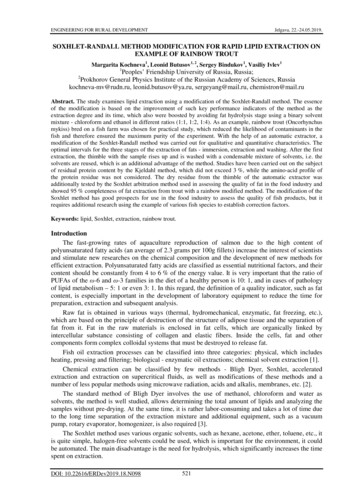
Transcription
ENGINEERING FOR RURAL DEVELOPMENTJelgava, 22.-24.05.2019.SOXHLET-RANDALL METHOD MODIFICATION FOR RAPID LIPID EXTRACTION ONEXAMPLE OF RAINBOW TROUTMargarita Kochneva1, Leonid Butusov1, 2, Sergey Bindukov1, Vasiliy Ivlev11Peoples’ Friendship University of Russia, Russia;Prokhorov General Physics Institute of the Russian Academy of Sciences, Russiakochneva-mv@rudn.ru, leonid.butusov@ya.ru, sergeyang@mail.ru, chemistron@mail.ru2Abstract. The study examines lipid extraction using a modification of the Soxhlet-Randall method. The essenceof the modification is based on the improvement of such key performance indicators of the method as theextraction degree and its time, which also were boosted by avoiding fat hydrolysis stage using a binary solventmixture - chloroform and ethanol in different ratios (1:1, 1:2, 1:4). As an example, rainbow trout (Oncorhynchusmykiss) bred on a fish farm was chosen for practical study, which reduced the likelihood of contaminants in thefish and therefore ensured the maximum purity of the experiment. With the help of an automatic extractor, amodification of the Soxhlet-Randall method was carried out for qualitative and quantitative characteristics. Theoptimal intervals for the three stages of the extraction of fats - immersion, extraction and washing. After the firstextraction, the thimble with the sample rises up and is washed with a condensable mixture of solvents, i.e. thesolvents are reused, which is an additional advantage of the method. Studies have been carried out on the subjectof residual protein content by the Kjeldahl method, which did not exceed 3 %, while the amino-acid profile ofthe protein residue was not considered. The dry residue from the thimble of the automatic extractor wasadditionally tested by the Soxhlet arbitration method used in assessing the quality of fat in the food industry andshowed 95 % completeness of fat extraction from trout with a rainbow modified method. The modification of theSoxhlet method has good prospects for use in the food industry to assess the quality of fish products, but itrequires additional research using the example of various fish species to establish correction factors.Keywords: lipid, Soxhlet, extraction, rainbow trout.IntroductionThe fast-growing rates of aquaculture reproduction of salmon due to the high content ofpolyunsaturated fatty acids (an average of 2.3 grams per 100g fillets) increase the interest of scientistsand stimulate new researches on the chemical composition and the development of new methods forefficient extraction. Polyunsaturated fatty acids are classified as essential nutritional factors, and theircontent should be constantly from 4 to 6 % of the energy value. It is very important that the ratio ofPUFAs of the ω-6 and ω-3 families in the diet of a healthy person is 10: 1, and in cases of pathologyof lipid metabolism – 5: 1 or even 3: 1. In this regard, the definition of a quality indicator, such as fatcontent, is especially important in the development of laboratory equipment to reduce the time forpreparation, extraction and subsequent analysis.Raw fat is obtained in various ways (thermal, hydromechanical, enzymatic, fat freezing, etc.),which are based on the principle of destruction of the structure of adipose tissue and the separation offat from it. Fat in the raw materials is enclosed in fat cells, which are organically linked byintercellular substance consisting of collagen and elastic fibers. Inside the cells, fat and othercomponents form complex colloidal systems that must be destroyed to release fat.Fish oil extraction processes can be classified into three categories: physical, which includesheating, pressing and filtering; biological - enzymatic oil extractions; chemical solvent extraction [1].Chemical extraction can be classified by few methods - Bligh Dyer, Soxhlet, acceleratedextraction and extraction on supercritical fluids, as well as modifications of these methods and anumber of less popular methods using microwave radiation, acids and alkalis, membranes, etc. [2].The standard method of Bligh Dyer involves the use of methanol, chloroform and water assolvents, the method is well studied, allows determining the total amount of lipids and analyzing thesamples without pre-drying. At the same time, it is rather labor-consuming and takes a lot of time dueto the long time separation of the extraction mixture and additional equipment, such as a vacuumpump, rotary evaporator, homogenizer, is also required [3].The Soxhlet method uses various organic solvents, such as hexane, acetone, ether, toluene, etc., itis quite simple, halogen-free solvents could be used, which is important for the environment, it couldbe automated. The main disadvantage is the need for hydrolysis, which significantly increases the timespent on extraction.DOI: 10.22616/ERDev2019.18.N098521
ENGINEERING FOR RURAL DEVELOPMENTJelgava, 22.-24.05.2019.The method of accelerated solvent extraction is based on the use of high temperature andpressure, which reduces the extraction time and the amount of the solvent used, but this method issignificantly more expensive than the above [4].Supercritical extraction using carbon dioxide can be used to extract substances that are thermallyunstable or prone to oxidation, which refers to lipids. The method does not use organic solvents, whatmakes its undoubted advantage, has a high extraction rate, but with all the benefits it is incrediblyexpensive [5].Due to the fact that aquatic biological resources are distinguished by a large variety in thechemical structure of lipids, there are many aspects of extraction. It determines the possibility ofimprovements for the existing extraction methods and creation of new ones, which are meant forcertain species of fish, such as discussed in this article salmon species.In this research we consider different modifications of the Soxhlet method using as the example offish a rainbow trout (Oncorhynchus mykiss) with the use of automatic extraction setup, which inaddition to automating the process can significantly reduce the consumption of the amount of thesolvent, but at the same time has only general recommendations for extraction using a modifiedSoxhlet method.Materials and methodsRainbow trout from a fish farm was used in the research. Pre-defrosted to -1 С (in the thick) fishwas purified from mechanical impurities, butchered, removed all the entrails with caviar or milt, thespine, ribs and skin removed.Filet was milled in a meat grinder until smooth. Samples of the resulting mass were taken anddried in an oven at 105 ºС for 120 minutes. Drying stage is necessary for Soxhlet methods to removemoisture. Samples of 5 0.1 g were used for the Soxhlet method as an optimal for raw materials withfat content from 6 to 10 %, what is governed by the manual for the automatic extractor and alsobecause 5 grams of the test substance completely occupies the working surface of the extractionsleeve.Arbitrage method of Bligh Dyer [6] was performed manually and because it does not need drying,the results of extraction were recalculated by the equation (1) for correct comparison with Soxhletautomatic extraction methods.m T 2 T1 100 ,SW(1)where m – amount of extracted lipids (%);T2 – glass weight before extraction;T1 – glass weight after extraction;SW – weight of the sample.Soxhlet methods with dried raw fat were performed using different solvents and their ratios withan automatic fat extractor VELP SER 148/6 under different temperature. The list of the methods withabbreviations and the result information are presented in Table 1.Methods A & G as standard methods for manual and automatic extraction were iterated 3 times,methods B-F were iterated 5 times. Average values are shown in the results table (Table 1).NMR spectra of the extracted samples were measured by Jeol JNM ECA 600 and processed by MnovaNMR Software.Results and discussionDifferent ratios of ethanol-chloroform mixtures, as well as different temperatures at which fat willbe extracted, were used during the experiment to determine the optimal method (methods a-f).Because the research is aimed at automatic extraction, the recommended method for automaticextractors was also prepared using diethyl ether. The results of the study are shown in Table 1.Method (a) used in Russia as an arbitration method [7] showed the lipid content of 7.5 %. Theresidual substances after extraction were examined for the protein content (21.8 %), moisture522
ENGINEERING FOR RURAL DEVELOPMENTJelgava, 22.-24.05.2019.(68.88 %) and ash (1.5 %), what in total gives 99.68 % and indicates the complete extraction of lipidsusing the control method. In our study, we proceeded from the results of this method, taking them asthe reference value.In view of possible discrepancies in the amount of extracted lipids, 5 extractions were performedfor each of the methods; Table 1 shows the average values of the extracted lipid relative to the samplein percent. We noted that for methods, which use ethanol in some cases, we observe a decrease inreproducibility; if for the Bligh Dyer method the amount of extracted lipids differed by no more than0.1 %, which in turn can be attributed to weight errors of the sample on the stage of preparation, usingethanol these discrepancies were up to 3 % relative to each other.Table 1Extraction rature, ºСAveragequantity oflipid, %AC2H5OH,CH3Cl, H2OBligh and lC2H5OHCH3ClEt2OAt the same time, we eliminate the measurement error associated with the initial mass of thesample, due to the characteristics of the Soxhlet method, in which wiping of glass used for the samplewith a cotton wool wetted in a solvent with the subsequent transfer to the extractor’s sleeve isprovided.According to Table 1, the samples obtained by the Soxhlet method using the ethanol-chloroformsolvent combination in a 1:2 ratio at an extraction temperature of 210 ºC (e), 1: 4 at 160 ºC (f), are theclosest to the arbitration method (a), as well as the extract obtained using diethyl ether as a solvent (g).For sample (b), we observed solid formations, which are usually associated with a complex ofchemical processes of lipo-amine condensation and formation of melanoidins, which explains thesmall yield percentage of the method. Increasing the temperature of the reaction mixture also affectsthe formation of flocculent inclusions, i.e. accelerates polymerization.Figure 1 shows the changes of the extracted samples colors, so the Bligh Dyer method (a) as wellas Soxhlet extraction with diethyl ether have orange colors, caused by the presence of the pigmentAstaxanthin inherent in the studied fish and extracts obtained by binary mixtures are quite darkbecause of the polymerization process.Extraction with chloroform-ethanol mixtures at temperatures below 160 ºC was ineffective due toincomplete evaporation during the sample drying step. In turn, increasing the amounts of ethanolresults in the need to increase the extraction temperature, because active ethanol evaporation occursdirectly at 210 ºC.Extraction by the classical method for the automatic extractor using diethyl ether showedincomplete extraction of lipids (6.84 % vs. 7.5 % as etalon value), which confirms the theory thatbinary solvents [8] for this kind of products are necessary.523
ENGINEERING FOR RURAL DEVELOPMENTJelgava, 22.-24.05.2019.Samples obtained by the arbitration method (a), the classical method for automatic extraction (g),as well as by Soxhlet with use of binary mixtures of chloroform and ethyl alcohol in a ratio of 1: 4 (f)and 1: 2 (e) have been investigated for nuclear magnetic resonance (Fig. 2).Fig. 1. Colors of extracted samples F, E, G and AThe spectra of the samples obtained by the methods (f, e, d) are identical to the spectrum of thearbitration method using lipid signals, but there is also an additional signal at 3.36 ppm. Method (e) ischaracterized by the presence of an additional quartet signal of ethanol (3.72 ppm) and a signal notrelated to the fat fraction (3.22 ppm), which is not explained in this paper.The data obtained confirm the need to increase the extraction temperature when using ethanol in abinary mixture of solvents in an amount greater than 25 %. At the same time, an increase of theextraction temperature, as mentioned above, can increase the reactivity of the mixture and cause theformation of melanoidins and, therefore, reduce the extraction yield.Fig. 2. NMR stack spectra of samples F (1), E (2), G (3), A (4)Nevertheless, the obtained results are very important, since the use of a binary mixture of solventsallows us to avoid the stage of hydrolysis and, accordingly, significantly reduce the time of extraction.Due to the lack of standards for automatic extraction, the extraction time requires careful selection foreach type of fish. In our work it was a total of 2 hours: 30 minutes of immersion in boiling solvent, 60minutes of irrigation flushing time and 30 minutes of solvent recovery time. For a binary mixture, apreliminary stage of hydrolysis of the sample is not required; this significantly reduces the extraction524
ENGINEERING FOR RURAL DEVELOPMENTJelgava, 22.-24.05.2019.time up to 3 hours. At the same time, such time savings require detailed consideration of theinteraction with the sample and the solvent mixture, the search for their optimal ratio and temperatureextraction mode, as it was done in this study.According to the results of our study, a modification of the Soxhlet method for automaticextractor using a binary solvent mixture of ethanol - chloroform in a 1:4 ratio has a good convergencewith the Bligh Dyer’s arbitration method – 7.6 % vs. 7.5 % of extracted lipids and more effective thanrecommended by the manufacturer Soxhlet method with the use of diethyl ether, which gives 6.84 %of fat.These results could be recommended for manufacturers of such devices for inclusion in thetechniques and also for modification of extractors by the use of more resistant materials with theassumption that they are reproducible for salmon species.ConclusionsExtraction of intracellular lipids from rainbow trout was investigated using an automatic extractorwith a binary mixture of ethanol-chloroform solvents; different ratios alcohol - chloroform were testedas well as a comparison with the methods of Bligh and Dyer method and Soxhlet extraction withdiethyl ether was given.It was established that for a 1:4 ratio of ethanol-chloroform mixture, the extraction temperatureshould be within 160, and increasing the proportion of ethanol to 50 percent or more requires anincrease in the extraction temperature to 210.Comparison of the lipid samples obtained using binary mixtures of solvents and the samplesobtained by extraction using the arbitrary method of Bligh Dyer and Soxhlet using diethyl ether wascarried out, beginning of lipoamine polymerization with increasing the extraction temperature wasshown.NMR spectroscopy shows the relationship of increasing the mass of the extract with increasingconcentration of ethanol in the solvent mixture.The modified method is significantly more effective than the method recommended by themanufacturer – 7.6 % vs. 6.84 % and is comparable to the arbitration method with the hydrolysis stage– 7.5 %.AcknowledgementsThis publication was prepared with the support of the “RUDN University Program 5-100”.References[1] Adeoti I.A., Hawboldt K. A review of lipid extraction from fish processing by-product for use asa biofuel. Biomass and Bioenergy, pp. 330-339.[2] Ivanovs K., Blumberga D. Extraction of fish oil using green extraction methods: a short review.Energy Procedia, vol. 128, 2017, pp. 477-483[3] Bligh, E.G. and Dyer, W.J. A rapid method for total lipid extraction and purification. CanadianJournal Biochemistry and Physiology, vol 37, 1959, Canada pp. 911-917[4] Mottaleb, M. A., Sarker S. D. Accelerated Solvent Extraction for Natural Products Isolation.Natural Products Isolation, vol. 864, 2012, pp. 75-87.[5] Rubio-Rodríguez, N. de Diego, Beltrán S. M., Jaime, I. S., Sanz M. T. Supercritical fluidextraction of fish oil from fish by-products: A comparison with other extraction methods. Journalof Food Engineering, vol. 109(2). 2012, pp. 238-248[6] Bligh E. G., W. J. Dyer. A rapid method of total lipid extraction and purification. CanadianJournal of Biochemistry and Physiology, 1959, 37(8): 911-917[7] GOST 7636-85. “Fish, marine mammals, invertebrates and products of their processing. Methodsof analysis (with change 1)” (In Russian).[8] Biondo P. B. F., et al. A new method for lipid extraction using low-toxicity solvents developedfor canola (Brassica napus L.) and soybean (Glycine max L. Merrill) seeds Analytical Methods,vol. 7, 2015, pp. 9773-9778.525
modification of the Soxhlet-Randall method was carried out for qualitative and quantitative characteristics. The optimal intervals for the three stages of the extraction of fats - immersion, extraction and washing. After the first extraction, the thimble with the sample rises up and is washed with a condensable mixture of solvents, i.e. the










